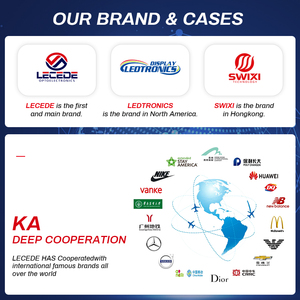
All categories
Featured selections
Trade Assurance
Buyer Central
Help Center
Get the app
Become a supplier

(154242 products available)




















































The outdoor advertising led display screen comes in several types. Each type has unique features and benefits. Here are the most common types:
These screens are designed to display constant advertisements and have one set of LED pixel configurations. Fixed LED billboards are commonly situated in high-traffic zones and are ideal for businesses desiring to project a broad audience consistently. They are durable, weatherproof, and can be seen clearly, even in direct sunlight.
Mobile LED screens are mounted on vehicles, allowing advertisers to reach various areas dynamically. This flexibility is ideal for event marketing or promotional campaigns targeting specific locales. The screens are often retractable or foldable, allowing for easier parking and storage.
These screens provide advertisers with the option to display different content at various times throughout the day. This feature enables the display of multiple ads sequentially, maximizing the screen's usage. Such screens are typically used in urban areas, where diverse audiences are targeted at different times.
These enable consumer engagement through touch, mobile integration, or social media connections.
These are environmentally friendly options. They utilize solar energy to reduce electricity costs. This is especially useful in regions where power supply is inconsistent or for campaigns prioritizing sustainability.
The durability of outdoor advertising LED display screens is vital. This is due to exposure to the elements and constant usage. The construction materials of these screens must withstand diverse weather conditions, from rain and snow to extreme heat and strong winds.
The housing or frame of an outdoor LED screen is commonly constructed from aluminum or steel. These metals are lightweight yet robust enough to support large screens. Aluminum is frequently the material of choice due to its resistance to rust, while steel provides enhanced strength. In premium models, die-cast aluminum is utilized for the back cover to ensure precise construction and rigidity.
IP ratings (Ingress Protection ratings) are used to categorize the water and dust protection of LED screens.
Outdoor LED screens are fitted with anti-UV materials or coatings such as polycarbonate. This safeguards the screen from sun damage, ensuring sustained vibrancy of the colors and contrast. It also reduces the risk of screen cracking or fading over time.
High-performance outdoor LED screens integrate advanced thermal management systems. These include heat sinks or cooling fans that regulate temperature in extreme conditions.
These are especially critical in summer when prolonged sunlight can cause LEDs to overheat. This leads to a decrease in efficiency and a shorter lifespan. These screens are designed to operate within a range of temperatures.
An outdoor advertising led display screen is versatile. It can cater to various advertising needs. Here are the most common usage scenarios for these screens:
High-traffic locations make urban billboards ideal for instant visibility to huge populations. Businesses can project consistent brand awareness through vibrant, dynamic content. These displays are a go-to option for firms wishing to make a big impression in metropolitan areas due to their size and clarity.
These screens can be installed in arenas or locations. This offers a dramatic technique for broadcasting events like concerts, sports, or exhibitions. They can display event schedules, ticket information, and sponsor advertisements. This improves the overall visitor experience and creates a lively atmosphere.
Installing LED screens in buses, trains, or stations allows advertising while people commute. These screens can display numerous ads. This enables brands to engage consumers in transit and capture captive audiences in popular areas.
These screens allow shops to showcase items or promotions to passersby. Strategically installed in storefronts, these vibrant displays can catch potential consumers' attention from a distance. Retailers can modify their content in real time, allowing them to respond quickly to market demands or personal sales events.
Sports arenas, parks, and outdoor activity sites often utilize these screens to promote upcoming games, advertisements, and community events
Certain factors will help buyers to choose the best outdoor advertising led display screen that suits their clients' needs. Here are the most essential ones:
A lower pixel pitch gives better resolution. High-resolution screens are ideal for busy areas where viewers will be close. In contrast, lower resolutions may suffice in less crowded areas. Selecting the appropriate resolution ensures that the material appears sharp and captivates the audience.
Higher brightness levels ensure that the material is visible during the day. Thus, it captures prospective clients effectively.
Businesses should measure these factors based on their placement since brightness needs vary based on ambient light conditions. Outdoor locations require brighter screens to combat sunlight, while shaded locations need less brightness.
Advanced software solutions enable advertisers to handle material and campaigns easily. Businesses should choose displays with cloud-based content management systems.
Complex displays may incur higher labor costs and time in maintenance. Thus, businesses should evaluate the installation process and upkeep requirements. Simpler units may have lower lifetime running costs.
Outdoor displays need superior weatherproofing and durability.
Yes, manufacturers make these screens for sturdy performance. They integrate advanced waterproofing and thermal management technologies. This protects the devices from overheating or internal damage.
Manufacturers use top-notch materials to prevent water damage. Thus, rain will not affect the screen's visuals, nor will it damage the screen.
Most manufacturers offer these screens with warranty periods. They offer a one to three-year warranty. Often, longer warranties apply to higher-end products. A warranty covers critical failures but not damage from poor weather or improper installation.
Yes, the recent models have wireless communication systems. They allow advertisers to update the display content from anywhere at any time. This technology is ideal for real-time promotions and dynamic advertising strategies.
LED screens comprise various advanced materials. The most common screen types have aluminum or steel frames. These materials are strong yet light. High-quality outdoor advertising led screens use marine-grade aluminum. It often forms parts exposed to extreme weather. This material is resistant to corrosion.